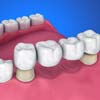- 01935 421 249
- CONTACT US
- •
- EMERGENCIES
- •
- FIND US
Dental Bridge
Dental Bridge
What is a Dental Bridge?

Bridges replace one or more missing teeth, by fixing the replacement teeth to the surface of the natural teeth each side of the gap - to bridge the gap. They may also be fitted to crowns at each side of the bridge. They can help correct bite issues and prevent remaining teeth from drifting out of position into the empty space.
Bridges are usually used where there are fewer teeth to replace, or when the missing teeth are only on one side of the mouth.
They can be made from metal, porcelain or a combination of both. The colour can be matched to the rest of your teeth to ensure they blend in and look natural.
Can I always have a bridge to replace missing teeth?
Bridges are only possible if you have enough strong teeth with good bone support. Your dentist will help you decide which is the best way for you to replace missing teeth.

How are Dental Bridges fitted?
An impression is taken of the mouth, using a soft mouldable material. This impression is given to a dental technician, who uses it to build exact plaster models of the upper and lower teeth and gums, which demonstrates how the teeth bite together.
Your teeth that will support the bridge are then prepared to take the fixings and to ensure that the bridge is not too bulky.
A second impression is then taken of the teeth and any gaps. This is also given to the dental technician, who will use it to build the bridge to the exact size, shape and colour required. This will ensure that the bridge fits comfortably and looks natural.
Whilst the bridge is being made, a temporary plastic bridge or crown may be fitted.
When the bridge is ready, it will be fitted and small adjustments made to ensure a comfortable bite is maintained, before it is fixed in place.
Smile Renovation
Creating the gorgeous smile you deserve
We offer a range of treatments to help you realize your great smile
FIND OUT MORE

Why should I replace missing teeth?
Your appearance is one reason. Another is that the gap left by a missing tooth can mean greater strain is put on the teeth either side. A gap can also mean your bite is affected, because the teeth next to the space can lean into the gap and alter the way the upper and lower teeth bite together. This can then lead to food getting packed into the gap, which causes both decay and gum disease.
Can I have a bridge fitted straight after having a tooth removed?
It can take up to 6 months for the gums to heal properly after an extraction. In most cases, you may need to wait at least 3 months after an extraction, before a bridge is fitted. Your dentist will be able to advise you on this, and suggest any temporary treatment available to fill the gap in your teeth whilst you wait.

